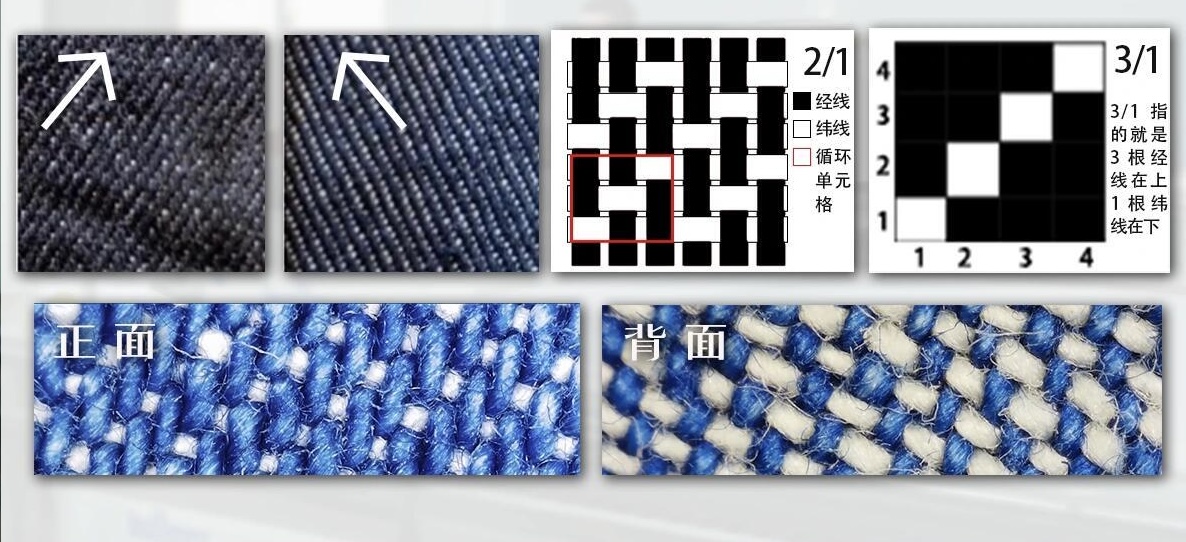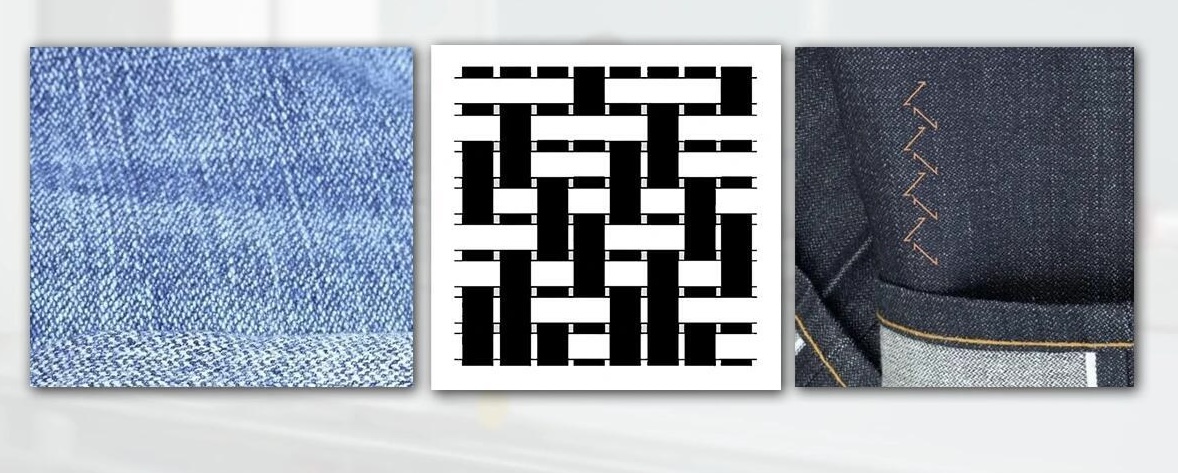ما هو قماش الدنيم المائل؟ تحليل شامل

مقدمة
Twill fabric exists with its diagonal rib pattern as a textile which serves multiple purposes in apparel and home furnishing products. The fabric known as denim twill stands out as a specific twill fabric which serves as the foundation for making denim jeans. The article explores denim twill through its definition alongside characteristics and differences with cotton twill and applications and answers common questions using expert sources for factual information.
Definition and Characteristics of Twill Fabric
Among textile weaving techniques Twill stands as one of the three main methods together with satin and plain weave. Twill fabric obtains its diagonal rib pattern through the weaving technique where weft threads move above multiple warp threads before moving below multiple warp threads. The specific interwoven pattern of twill fabric produces a distinctive diagonal line which serves as its main identifying feature. Twill fabric exists in multiple fiber forms which include natural cotton fibers together with synthetic polyester fibers leading to diverse fabric properties.
Twill fabric possesses three essential properties which include:
-
Balanced breathability and warmth: The fabric design of twill allows airflow through its structure while maintaining warmth levels for use across different environmental conditions.
-
Low elasticity: Twill fabrics show low elasticity because they maintain their dimensions without stretching.
-
Superior drape: The softness along with flexibility of twill makes it perfect for creating garments which require flowing silhouettes.
-
Versatile applications: Twill fabric proves suitable for multiple product applications because of its strong nature and attractive design thus it appears in denim jeans and casual trousers and shirts and bed linens.

نسج مائل
The specific properties of twill fabric make it the preferred material in textile manufacturing for functional as well as decorative uses.
Characteristics of Denim Twill
Denim twill serves as a specific cotton twill fabric which manufacturers use to create denim products specifically jeans. The 3×1 right-hand twill pattern in denim twill fabric makes each weft thread pass over three warp threads before moving under one which produces diagonal ribs that progress from right to left. The warp threads undergo indigo dyeing before the weft threads remain white which creates the characteristic blue color of denim. The unique dyeing technique together with the twill weaving method produces distinctive visual and functional features of denim twill fabric.
Key characteristics of denim twill include:
-
Rough texture: Denim twill displays a coarser texture compared to ordinary cotton twill which improves its touch and visual appearance.
-
Heavier weight: Denim twill exists as a heavy-duty material that works well for durable clothing items meant to handle heavy use.
-
Exceptional durability: The tight weave and high thread count of denim twill make it extremely durable against abrasion and tearing which makes it perfect for workwear as well as casual clothing.
-
Indigo dyeing: The indigo dye process produces a classic blue color that fades to create distinctive personal patina patterns which denim fans appreciate.

Twill selvedge jeans
The production of denim twill fabric requires several important operational stages.
-
Cotton spinning and weaving: The manufacturing process starts by spinning cotton into yarn which gets wound onto bobbins before the twill weave pattern creates the fabric.
-
Mercerizing: Cotton fibers undergo treatment with sodium hydroxide during the mercerizing process to gain strength and improved luster while enhancing dye binding capabilities.
-
Pre-shrinking: Fabric pre-shrinking serves to prevent wash-related shrinkage which helps garments keep their original dimensions.

حافة منخفضة التمدد
The manufacturing methods transform denim twill into a fundamental material for producing denim garments by providing durability and attractive appearance with functional properties.
Comparison Between Denim Twill and Ordinary Cotton Twill
While both denim twill and ordinary cotton twill employ the twill weaving technique, they differ significantly in composition, appearance, durability, comfort, and application. The following table provides a detailed comparison:
|
Aspect |
Denim Twill |
Ordinary Cotton Twill |
|---|---|---|
|
Fabric Composition |
Typically 100% cotton, with indigo-dyed warp and white weft |
Usually cotton or cotton blends, not necessarily dyed with indigo |
|
مظهر |
Coarser texture, heavier, prominent twill pattern, classic blue color |
Smoother finish, lighter, less pronounced twill pattern |
|
Durability & Strength |
Highly durable, suitable for heavy wear |
Less durable, better suited for formal or lighter use |
|
راحة |
Slightly rougher feel, but can be soft depending on specific fabric |
Generally smoother and softer to the touch |
|
Practical Application |
Jeans, jackets, workwear, overalls |
Formal trousers, shirts, curtains, upholstery |
The designers created denim twill to withstand heavy usage thus making it perfect for both everyday casual wear and professional workwear. Ordinary cotton twill focuses on delivering comfort with a stylish look which makes it perfect for official clothes and domestic interior design purposes.
Practical Applications
The main use of denim twill exists in denim jeans production since its durable nature and unique aging characteristics after washing and wearing make it highly valuable. The material stands up well to wear which makes it perfect for creating workwear items such as jackets and overalls and professional garments for outdoor workers and construction staff. The fabric shows excellent wear resistance while its unique aging process attracts users in casual wear markets.

twill jeans
The formal clothing sector uses ordinary cotton twill because it provides a smooth texture and lightweight construction which creates a polished finish for trousers jackets and shirts. The fabric serves as a popular material for home furniture products including curtains as well as upholstery and tablecloths because it offers both durability and attractive drapery. The wide range of applications for ordinary cotton twill fabric allows it to fulfill various design requirements and operational needs.

Twill suit
Frequently Asked Questions
-
Is Cotton Twill the Same as Denim?
Cotton Twill exists as a separate fabric from Denim despite sharing twill fabric characteristics.Denim represents a specific type of cotton twill fabric which gets its distinctive blue color from indigo dye for blue jeans production. Ordinary cotton twill exists as a versatile fabric because it derives from different materials and presents in various color options. -
Between cotton and twill which material is superior?
The selection between cotton and twill depends on the specific use case. The fabric benefits from its soft texture and natural breathability which suits making light casual clothing. The twill fabric made from cotton material provides improved durability and structure which makes it appropriate for official or demanding clothing needs. -
What is Twill Denim?
The twill weave with diagonal ribbing of cotton fabric makes twill denim suitable for creating traditional denim jeans which benefits from both its durability and its distinctive visual appeal. -
What is the Difference Between a Twill Jacket and a Denim Jacket?
The main distinction between a Twill Jacket and a Denim Jacket exists in their fabric materials. The fabric type of a twill jacket can be either cotton or blended materials which gives the garment both durability and structural support. The denim jacket exists solely from denim material which represents a particular type of cotton twill fabric because it delivers both its famous blue color and rugged properties. -
The different types of twill denim fabrics exist in the market today.
Twill denim exists in different types including:-
Standard Twill: Features the classic diagonal weave.
-
نسيج قطني مكسور: The unique texture of Broken Twill emerges from its interrupted diagonal design pattern.

نسيج قطني مكسور
-
Herringbone Twill: Herringbone Twill features a distinctive V-shaped pattern in its weave.

عظم السمكة (مشتق من نسيج قطني مائل)
-
جينز مطاطي: The addition of elastane to the fabric provides enhanced stretch capabilities.
-
